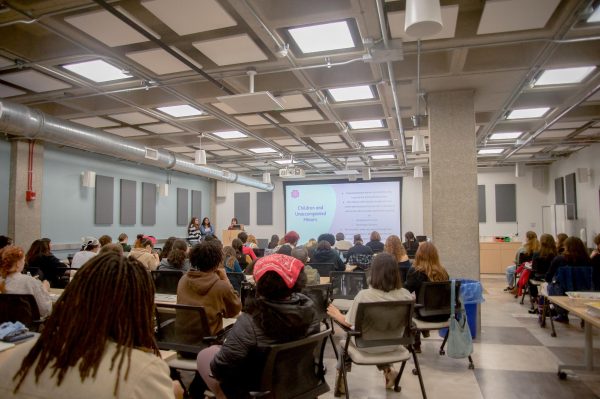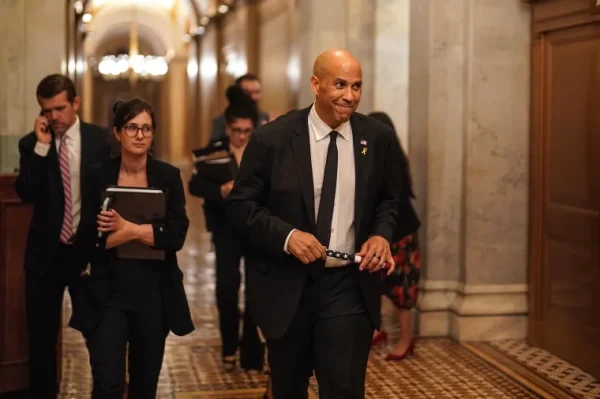Closing Dascomb Dining Presents As Many Problems As It Solves
While the administration’s potential decision to shut down Dascomb Dining Hall may reduce costs during a time of financial stringency, the decision has far-reaching implications that jeopardize the already-delicate balance of Campus Dining Services. Despite President Carmen Ambar’s transparency in announcing the possible change at her recent budget presentation, there are numerous logistical concerns that the administration has yet to adequately answer.
First, Ambar did not sufficiently address how the school plans to disperse Dascomb diners to other dining facilities. To compensate for the closure of Dascomb, the administration plans to expand DeCafé and Lord-Saunders Dining Hall hours, as if Lord-Saunders and Decafé could handle the extra diners that would normally be eating in Dascomb. Dascomb serves about 500 people every day for lunch, while Stevenson dining hall serves 600–800 (“Students, CDS Workers Protest Bon Appétit, The Oberlin Review, May 5, 2015). The number of diners in both Lord-Saunders and Stevenson would increase by a minimum of 250, assuming half of Dascomb’s diners moved to each space. However, it is likely that a majority of the Dascomb diners, who are largely Conservatory students and residents of South Campus, would eat at Lord-Saunders because of its location. Lord-Saunders is a small dining area and it can barely handle the traffic that it gets on Sunday. The idea that Lord-Saunders could adequately accommodate potentially hundreds more people on any given day hardly seems practical. These logistical concerns are compounded when one considers that fire codes regulate the number of people that can be in a room at any given time. The administration would have to be extremely vigilant that the additional diners don’t exceed fire code regulations in Stevenson or Lord-Saunders and would have to renovate or expand dining spaces to accommodate students who typically eat at Dascomb.
Even if Stevenson and Lord-Saunders could seat and feed the additional diners, these changes will likely lead to a massive accessibility issue during peak dining hours. For some students with mobility-related disabilities, navigating extremely crowded places — especially while carrying food — is difficult, if not impossible. The more students are crowded into a space, the more likely it is for students to be bumped or tripped, which can be dangerous for those with mobility-related disabilities. Crowded spaces can also be difficult for students with sensory-processing disabilities, which are common among individuals on the autism spectrum and are characterized by more intense sensory input, which can be overwhelming for these inviduals. Sounds are louder. Lights are brighter. Smells are stronger. Dining halls at busy hours are already overwhelming for students without disabilities. Adding hundreds more students could make dining halls and DeCafé completely inaccessible to students with sensory-processing disabilities. The administration must take these issues into consideration when deciding how many students a dining hall can serve.
Additional questions arise if Lord-Saunders is to become the only dining hall on South Campus. Afrikan Heritage House is a safe space for Black students on campus, and during the Gibson’s protests last year, Lord-Saunders was temporarily reserved and used exclusively as a safe space for Black students. Having the Lord-Saunders Dining Hall become one of two major dining halls on campus jeopardizes the Black community’s safe space during times of need, while also crowding it every day with people who have no affiliation with the dorm. If the administration has solidified the decision to make Lord-Saunders the only major dining hall on South campus without consulting and reaching consensus with the residents of the dorm or ABUSUA, they are being disrespectful to Black students and their space.
Making Lord-Saunders and Stevenson the main dining halls on campus will also further the divide between North Campus and South Campus. Most athletes tend to live on North Campus and eat in Stevenson, while most non-athletes live on South Campus and prefer to eat at Dascomb. However, Dascomb’s location is more central than Stevenson’s and therefore attracts a more diverse group of students, including some who live on North campus. If Dascomb closes, it seems logical that many of those diners who live on South Campus would opt for Lord-Saunders instead of Stevenson, and those who live on North Campus would choose Stevenson. By closing Dascomb, the administration would effectively minimize the interaction between students who live on different sides of campus.
Dascomb also serves as a social hub for first-years. Because of its location in an all-first-year dorm, it is a key space that allows first -years to build community and friendships that can support them during their time at Oberlin. Eliminating Dascomb takes away a major part of the first-year experience. If the administration wants to increase retention rates, giving first-years spaces to form relationships that could carry them through college is crucial.
Many Conservatory students also depend on Dascomb and have expressed dissatisfaction with this potential change to members of the editorial board. When they rush between class and practice, Dascomb is a convenient place to grab meals. None of the other options — Lord-Saunders, Stevenson, or DeCafé — are especially convenient for Conservatory students who are working with time crunches, sometimes carrying large instruments, and going back and forth to the Conservatory buildings.
Expanding the hours of existing dining options is not an adequate replacement for the hole that will be left by Dascomb Dining Hall. Something more must be done if the administration is serious about its closing.
One potential solution to the overcrowding problem is to separate DeCafé’s made-to-order from hot food options and its grocery options. The groceries that are sold in Decafé take up most of the space there, which often leads to overcrowding. If the groceries were moved to a different location that strictly sold groceries, this could allow for the expansion of lunch options. The new hot sandwich selections introduced this semester have been pretty successful, especially in offsetting increased sandwich and smoothie line traffic. If there was more space, pre-prepared and made-to-order food options could be further developed. For breakfast, they could serve pre-made breakfast burritos, have an oatmeal bar, offer more baked goods, and open the smoothie bar. Other options for lunch and dinner could include a wok station, quesadillas, a separate salad bar, and/or bringing back the old Rathskellar buffet and offering to-go containers. If Decafé offered more grab-and-go choices, it could alleviate the lunch and dinner rush at other dining halls. This would be a convenient option, as it is close to several main academic buildings, including King Building and the Science Center.
As the College faces difficult decisions regarding budget cuts, students will have to make sacrifices. We acknowledge that closing Dascomb may be a good option for alleviating the College’s financial burden and that in her financial presentations, Ambar said that all options are on the table. We want to stress that this also means that all consequences of major upcoming decisions — including the closure of Dascomb Dining Hall — must be on the table and must be open for further community input. Dascomb can close, but we want to ensure that the void its closure will leave will be filled to better meet student needs.



